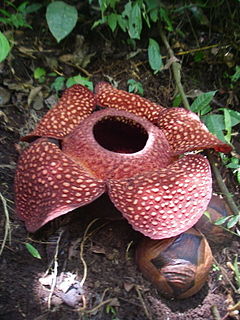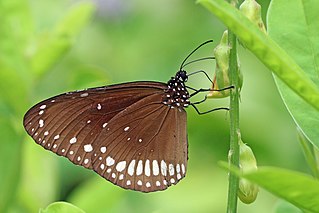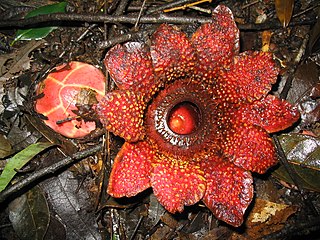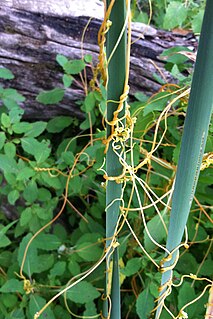
Rafflesia is a genus of parasitic flowering plants in the family Rafflesiaceae. The species have enormous flowers, the buds rising from the ground or directly from the lower stems of their host plants; one species has the largest flowers in the world. The genus contains approximately 28 species, all found in Southeast Asia, mainly in Indonesia, Malaysia, Thailand and the Philippines. For Western Europe, it was first discovered by French surgeon and naturalist Louis Deschamps in Java between 1791 and 1794, but his notes and illustrations, seized by the British in 1803, were not available to western science until 1861. The first British person to see one was Joseph Arnold in 1818, in the Indonesia rainforest in Bengkulu, Sumatra, after a Malay servant working for him discovered a flower and pointed it out to him. It was later named after Stamford Raffles, the leader of the expedition.

Cuscuta (dodder) is a genus of over 201 species of yellow, orange, parasitic plants also known as Amar bail in India. Formerly treated as the only genus in the family Cuscutaceae, it now is accepted as belonging in the morning glory family, Convolvulaceae, on the basis of the work of the Angiosperm Phylogeny Group. The genus is found throughout the temperate and tropical regions of the world, with the greatest species diversity in subtropical and tropical regions; the genus becomes rare in cool temperate climates, with only four species native to northern Europe.

Mistletoe is the common name for obligate hemiparasitic plants in the order Santalales. They are attached to their host tree or shrub by a structure called the haustorium, through which they extract water and nutrients from the host plant.

Nagaland is a state in northeastern India. It is bordered by the state of Arunachal Pradesh to the north, Assam to the west, Manipur to the south and the Sagaing Region of Myanmar to the east. Nagaland's capital city is Kohima and its largest city is Dimapur. It has an area of 16,579 square kilometres (6,401 sq mi) with a population of 1,980,602 per the 2011 Census of India, making it one of the smallest states of India.

Rafflesia arnoldii is a species of flowering plant in the parasitic genus Rafflesia. It is noted for producing the largest individual flower on Earth. It has a strong and unpleasant odor of decaying flesh. It is native to the rainforests of Sumatra and Borneo. Although there are some plants with larger flowering organs like the titan arum and talipot palm, those are technically clusters of many flowers.

Orobanchaceae, the broomrapes, is a family of mostly parasitic plants of the order Lamiales, with about 90 genera and more than 2000 species. Many of these genera were formerly included in the family Scrophulariaceae sensu lato. With its new circumscription, Orobanchaceae forms a distinct, monophyletic family. From a phylogenetic perspective, it is defined as the largest crown clade containing Orobanche major and relatives, but neither Paulownia tomentosa nor Phryma leptostachya nor Mazus japonicus.

Nuytsia floribunda is a hemiparasitic tree found in Western Australia. The species is known locally as moodjar and, more recently, the Christmas tree or Western Australian Christmas tree, as the display of intensely bright flowers during the austral summer coincides with the Christmas season.

E. core is a glossy-black, medium-sized 85–95 mm (3.3–3.7 in) butterfly with rows of white spots on the margins of its wings. E. core is a slow, steady flier. Due to its unpalatability it is usually observed gliding through the air with a minimum of effort. As caterpillars, this species sequesters toxins from its food plant which are passed on from larva to pupa to the adult. While feeding, it is a very bold butterfly, taking a long time at each bunch of flowers. It can also be found mud-puddling with others of its species and often in mixed groups. The males of this species visit plants like Crotalaria and Heliotropium to replenish pheromone stocks which are used to attract a female during courtship.

A parasitic plant is a plant that derives some or all of its nutritional requirement from another living plant. They make up about 1% of angiosperms and are found in almost every biome. All parasitic plants have modified roots, called haustoria, which penetrate the host plant, connecting them to the conductive system – either the xylem, the phloem, or both. For example, plants like Striga or Rhinanthus connect only to the xylem, via xylem bridges (xylem-feeding). Alternately, plants like Cuscuta and Orobanche connect only to the phloem of the host (phloem-feeding). This provides them with the ability to extract water and nutrients from the host. Parasitic plants are classified depending as to the location where the parasitic plant latches onto the host and the amount of nutrients it requires. Some parasitic plants are able to locate their host plants by detecting chemicals in the air or soil given off by host shoots or roots, respectively. About 4,500 species of parasitic plant in approximately 20 families of flowering plants are known.

Orobanche uniflora, commonly known as one-flowered broomrape, one-flowered cancer root, ghost pipe or naked broomrape, is an annual parasitic herbaceous plant. It is native to much of North America, where it is a parasitic plant, tapping nutrients from many other species of plants, including those in the families Asteraceae and Saxifragaceae and in the genus Sedum. The name "orobanche" can be translated to "vetch-strangler" and "uniflora" can be translated to "single-flower".

Rhododendron arboreum, the tree rhododendron, is an evergreen shrub or small tree with a showy display of bright red flowers. It is found in Bhutan, China, India, Myanmar, Nepal, Sri Lanka, Pakistan and Thailand. It is the national flower of Nepal. In India it is the state tree of Uttarakhand and state flower of Nagaland.

Bombylius major is a parasitic bee mimic fly. B. major is the most common type of fly within the Bombylius genus. The fly derives its name from its close resemblance to bumblebees and are often mistaken for them.

The Dzüko Valley is a valley located at the borders of the states of Nagaland and Manipur in Northeast India. This valley is well known for its natural environment, seasonal flowers and flora & fauna.
Rafflesia philippensis is a parasitic plant species of the Rafflesiaceae family that was named by Francisco Manuel Blanco in his Flora de Filipinas in 1845. The species is known only from a mountain located between the provinces of Laguna and Quezon, Luzon where it was first discovered. Its plant host is Tetrastigma pisicarpum. This species went unnoticed since its first description by Blanco but was rediscovered in 2003 by members of the Tanggol Kalikasan, a local environment conservation group in Quezon province who first saw and photographed the open flower of this species. It was brought to the attention of Manuel S. Enverga University (MSEUF), who formed a team composed of students and faculty to document the newly discovered Rafflesia species.

Sapria himalayana is a rare holoparasitic flowering plant related to Rafflesia found in the Eastern Himalayas. Sapria himalayana represents the extreme manifestation of the parasitic mode, being completely dependent on its host plant for water, nutrients and products of photosynthesis which it sucks through a specialised root system called haustoria. These haustoria are attached to both the xylem and the phloem of the host plant.

Mitrastemon is a genus of two widely disjunct species of parasitic plants. It is the only genus within the family Mitrastemonaceae. Mitrastemon species are root endoparasites, which grow on Fagaceae. It's also a non-photoysthetic plant that parasitizes other plants such as Castanopsis sieboldii. The parasitic plant was first discovered by botanist Eizi Matuda during an expedition to Mt. Ovando in the state of Chiapas, Mexico. The different species were originally named by a friend of Matuda, Yamamoto in 1925–1926. Mitrastemon yamamotoi is a protandrous plant. Its flowers go through a male phase before transforming into their final female form. The flowers of M. yamamotoi attract a variety of insects ranging from wasps to flies and beetles. Among these, beetles are the best pollinators for this plant since their visit to the flower would pick up a large amount of pollen and they would pollinate from each of the flowers that they had already visited. The plant is endemic to tropical and subtropical forest regions such as Southeast Asia and Japan.

Dendrophthoe falcata is one of the hemiparasitic plants that belong to the mistletoe family Loranthaceae. It is the most common of all the mistletoes that occur in India. At the moment reports say that it has around 401 plant hosts. The genus Dendrophthoe comprises about 31 species spread across tropical Africa, Asia, and Australia among which 7 species are found in India.

Balanophora fungosa, sometimes known as fungus root is a flowering plant in the family Balanophoraceae and occurs in South Asia, Southeast Asia, Australia and some Pacific Islands. It is an obligate parasite growing on the roots of rainforest trees. The flowering structure is shaped like a puffball but in fact consists of a globe covered with thousands of tiny female flowers. The globe is surrounded at its base by a much smaller number of male flowers. In flower, the plant emits an odour resembling that of mice.

Cuscuta gronovii is a yellow vine that grows as a parasite off other plants. It is a dicot.

Peraxilla colensoi, the scarlet mistletoe, is a shrubby parasitic plant composed of broad, leathery leaves that grow up to 8 cm long and have a red edge. The common name is derived from the scarlet petals of the plant that bloom every October to January. These mistletoes are parasitic plants whose seeds attach themselves to host plants. The most common host for these plants is the silver beech. The plant can grow up to 3 meters tall and are often located in low altitudes throughout the North and South Islands of New Zealand.

















